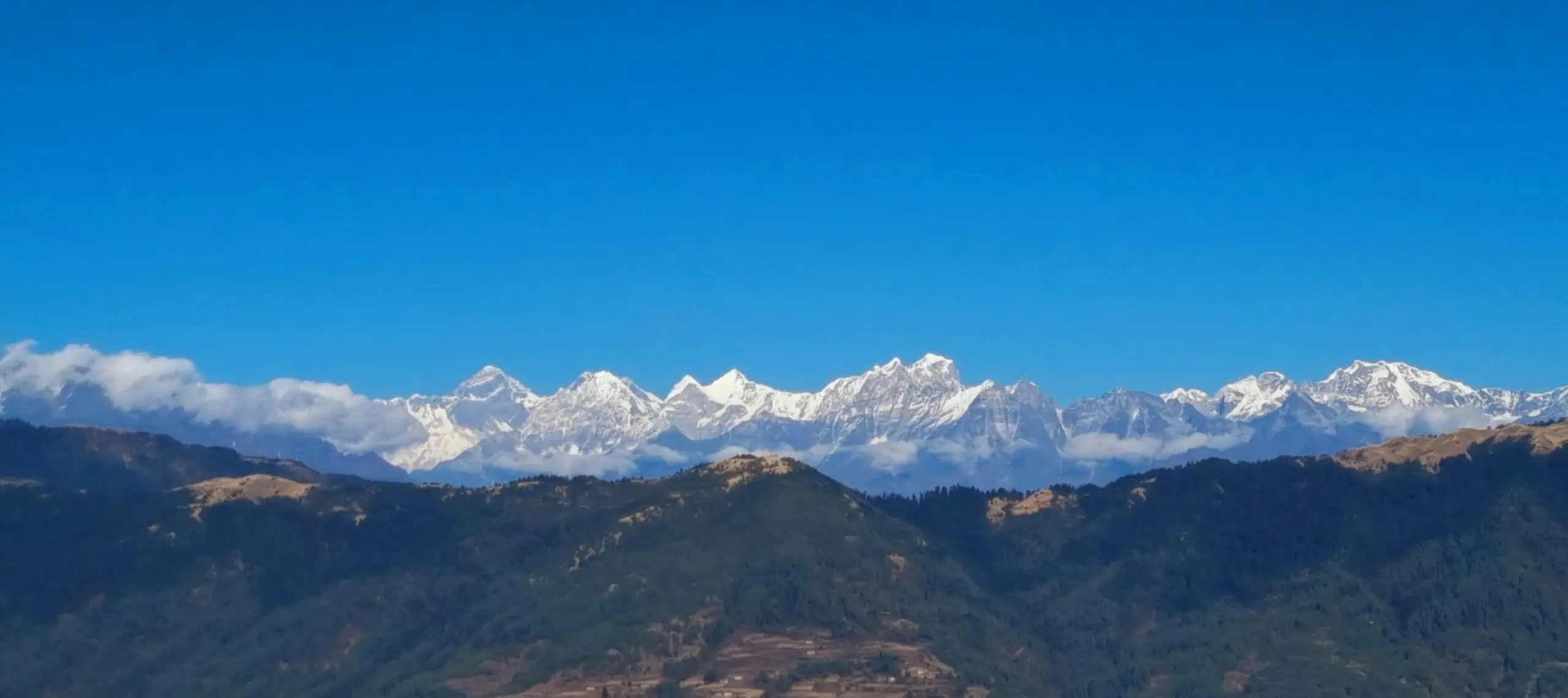
Round Annapurna Trek 19 Days
USD 1,350
USD 1,199 per person
| Activities | - | Fitness Level | Moderate |
| Max Elevation | 5416m | Commute | Kathmandu to Pokhara |
| Best Month | Autumn,Spring,winter | Group Size | Min: 2, Max: 10+,single |
| Arrival on | Kathmandu | Depart From | Kathmandu |
| Meal | B L D | Duration | 19 Days |
| Stay | Hotel & Tea House | Price | USD 1,199 per person |
Round Annapurna Trek is a complete trek to explore the entire Annapurna massif reaching the zenith at Thorong-la Pass.
Round Annapurna is a moderate to fairly challenging trek taking you to the beautiful landscape of Manang, Jomsom and Muktinath. In this trek, trekkers grasp an opportunity to explore the fascinating views of the southern and northern Himalayas along with beautiful landscape, culture, and forest. Another main attraction and electrifying moment is awaiting when crossing the highest pass- the Thorong-la Pass. It will takes you down to an important holy place, Muktinath. This place is a symbol of unity and combine belief of both the Hindus and Buddhist. In addition, if you have limited time and wish to enjoy natural beauties, enhance cultural experiences; you could join our Manang Valley and Annapurna Circuit Trek-15 Days or Tilicho Lake and Annapurna Circuit Trek-15 Days. If you are not satisfied with this itinerary or if you want to customize this package in your timeline or budget, then you could contact us, or email to [email protected]
Outline Itinerary:
Day 01: Arrival day in Kathmandu (1350m/4428 ft) (Meal: Dinner)
Day 02: Rest Day, Option for Sightseeing Tour in Kathmandu (1350m/4428 ft) (Meal: Breakfast)
Day 03: Drive to Besisahar, ( 760 m/ 2510 ft)Drive: 8-9 hrs or Jeep. (Meal: BLD) Day 04: Jeep drive to Chame (2670 m/8810 ft) Drive: 7/8 hrs. (Meal: BLD)
Day 05: Trek from Chame to Pisang (3300m/10890 ft) Trek: 5-6 hrs. (Meal: BLD) Day 06: Trek from Pisang to Manang ( 3540 m/ 11680 ft) Trek: 5-6 hrs. (Meal: BLD) Day 07: Acclimatization day at Manang village (3540 m/ 11680 ft) (Meal: BLD) Day 08: Trek from Manang to Yak Kharka ( 4,000 m/ 13200 ft) Trek: 5-6 hrs. (Meal: BLD)
Day 09: Trek from Yak Kharka to Thorong Phedi (4450 m/ 14685 ft) Trek: 5-6 hrs. (Meal: BLD)
Day 10: Trek to Muktinath (3800 m/12540 ft) - via Thorung La pass ( 5416 m/ 17873 ft) Trek: 7-8 hrs. (Meal: BLD)
Day 11: Trek from Muktinath to Marpha (2670 m/ 8810 ft) Trek: 5-6 hrs. (Meal: BLD)
Day 12: Trek from Marpha to Ghasa (2010 m/ 6630 ft) Trek: 5-6 hrs. (Meal: BLD) Day 13: Trek from Ghasa to Tatopani (1190 m/3927 ft) Trek: 5-6 hrs. (Meal: BLD) Day 14: Trek from tatopani to Ghorepani (2860 m/9438 ft) Trek: 6-7 hrs. (Meal: BLD) Day 15: Early morning excursion to Poon-Hill (3210 m/10531 ft) and trek to Tadapani ( 2600m/8528 ft) Trek: 7-8 hrs. (Meal: BLD)
Day 16: Trek from Tadapani to Ghandruk (1940 m/6400 ft) Trek: 4-5 hrs. (Meal: BLD)
Day 17: Trek from Ghandruk to Nayapul, 4-5 hrs, and drive to Pokhara (823 m/2691 ft) Drive: 1 hrs. (Meal: BL)
Day 18: Drive back to Kathmandu, evening Farewell Dinner (1350m/4428 ft. Meal: Breakfast/Dinner)
Day 19: Final departure ( 1350m/4428 ft. Meal: Breakfast)
Costs
What is included
🟢Airport transfer by Hiking Nepal office representative in a private vehicle
🟢Welcome Dinner at Typical Nepalese Restaurant with cultural dance show
🟢Farewell Dinner at finest restaurant in Thamel Kathmandu
🟢3 nights’ accommodation at Tourist Standard Hotel in Kathmandu with breakfast on twin sharing basis
🟢14 nights’ accommodation at well and comfortable Mountain Lodge available en-route during trek (Few nights’ at during trek with attached bathroom/toilets)
🟢1 night’s accommodation at 3 star Hotel in Pokhara with breakfast on twin sharing basis
🟢Full board meal during trek (Breakfast, Lunch, Dinner, tea & coffee, seasonal fruits, chocolate/s & biscuits)
🟢English speaking, First Aid and Eco-trained local trekking guide, Assistance guide as per the group size, porters (2:1)
🟢All the expenses for guide and porters along with Insurance
🟢Pokhara/Kathmandu transfer in a Tourist Bus- option for private vehicle and flight is available
🟢Kathmandu/Besisahar transfer in a private vehicle
🟢Beissahar/Chame drive in a local jeep
🟢Nayapul/Pokhara transfer in a private vehicle
🟢Annapurna Conservation Area Project (ACAP) fee
🟢Exclusive medical kit bag, Duffle Bag, Trekking T-shirt, Adventure Certificate
🟢Sleeping Bag and Down Jacket during Trek
🟢All government and local taxes as applicable
What is not included
🔴Nepal Visa - (Cost- US$- 30 for 15 days & $- 50 for 30 days)
🔴Lunch & evening meals while in Kathmandu and Pokhara (Except welcome/farewell dinner)
🔴Travel insurance
🔴Cost of personal nature expenses, Beverages (Mineral water or coca cola), cost of extra meals, snacks, phones bills, Internet, WiFi, laundry etc.
🔴Cost incurred during emergency, evacuations
🔴Tips for Guide/porters/driver …
Map

Altitude Chart

DETAILED ITINERARY
Day 1: Arrive Kathmandu (Altitude: 1350/4428 ft. Meal: Dinner)-
On your arrival in Kathmandu International Airport, one of our office representative will pick up you and escort you to the hotel as well as help you to check-in at hotel. After refreshment, you will be briefed about the next day trip. In the evening, we, the Hiking Nepal, will offer you a welcome dinner introducing Nepalese cuisine and culture.
Day 2: Rest Day, Option for Sightseeing tour in Kathmandu (Altitude: 1350/4428 ft. Meal: Breakfast)-
Day 2 is kept as rest day considering your late arrival or long travel to Nepal. You can use this day as a complete rest day or we can also organize sightseeing tour of cultural heritage sites in Kathmandu. In case of sightseeing tour, you will be introduced with guide and takes you to UNESCO Heritages sites of the valley where you will observe living heritage of Medieval Nepal – Witness the biggest Hindu temple of Nepal, Pashupatinath and capture the sacred moments of Hindu death ritual at Aryaghat in Pashupatinath. Stroll the lively streets of Kathmandu Old Market Asan to Kathmandu Durbar Square and visit the home of The Living Goddess Kumari, Nepalese style of Architecture as well as astonishing wooden carving. A short drive from Kathmandu Durbar Square will take you to a hill top stupa called as “Swyambhu” meaning “self -emerge” and belief that the hill emerged impulsively from the great lake that once covered Kathmandu valley.
Day 3: Drive to Besisahar, (Altitude: 760 m/ 2510 ft. Drive: 8-9 hrs. – bus/ 6 hrs. – Jeep Meal: BLD)-
After having breakfast, our guide will meet you at hotel to drive to Besisahar. Recheck your luggage and be ready for a drive. Following River Marshyangdi, you will reach at Besisahar. On the way, you can explore the Green Mountain, scattered village and refreshing landscape. Stay overnight at local lodge.
Day 4: Jeep drive to Chame (Stopover for acclimatization) (Altitude: 2670 m/8810 ft. Drive: 7/8 hrs. - local bus Meal: BLD)-
From Besisahar, catching a local bus, you will starts to drive in a bumpy road towards Chame. It is a small village of the Annapurna Region at an elevation of 1430 m. You can enjoy waterfall that attracts both the local and tourists. Stay overnight at local lodge.
Day 5: Trek Chame to Pisang (Altitude: 3,300m/10890 ft. Trek: 5-6 hrs. Meal: BLD)-
Today, you will have a steep walk through dense forest into a narrowed valley. Crossing the raging Himalayan River at two points 2,910m & 3,040m are absolute highlights of the trek. Just crossing a suspension bridge at 3040m, the stunning view of Rocky Hill Paungda Danda feasts catch by the eyes. Beyond here, the course connects towards Pisang on a steep trail. Pisang, nestles between 3,200m and 3,300meters.
Day 6: Trek Pisang to Manang (Altitude: 3,540 m/ 11680 ft. Trek: 5-6 hrs. Meal: BLD)-
After breakfast, you will walk through the arid & higher region of Manang. As you trek higher, the region affected being at the rain shadow of Annapurna comes into sight. Natives of this county flock yaks most of the times of the year and cultivate crops for a very short period of the year. As you leave Pisang, you will tread along the northern via Ghyaru for the better views of the Himalayan peaks throughout the trail that chases along the northern bank of the river. Now, you will arrive to Munchi. Beyond Munchi, the trail passes the charming and the authentic village of Braga 3475m. The last push brings to Manang.
Day 7: Acclimatization day at Manang village (Altitude: 3,540 m/ 11680 ft. Meal: BLD)-
Today, a time for rest and acclimatize properly with altitude. However, it does not mean that you have to spend time by staying at lodge and read books. You can go for short walks to higher altitude around the village where you can witness more of raw nature of the region. Your guide is the best man to take you to the best destination.
Day 8: Trek Manang to Yak Kharka (Altitude: 4,000 m/ 13200 ft. Trek: 5-6 hrs. Meal: BLD)-
Today, you will trek to higher altitude. After a day rest in Manang, you will not have acclimatization issue. However, gaining 500 m height trekking along the gradual uphill climb is quite an adventure. As the trek begins, you will crosses a stream, climbs to a village of Tenki and continue to ascend the Marsyangdi Valley, turning northwest up the valley of Jarsang Khola. You will further passess the small village of Ghunsa and following the trail through the meadows. Here, you can see the horses and yaks grazing. Crossing a wooden suspension bridge, you will encounters series of mani wall, eventually, you reach Yak Kharka at 4,000m. Yak Kharka is the yak graze land and hence signs of yak herders and thin vegetation can be seen there. Overnight at Yak Kharka.
Day 9: Trek Yak Kharka to Thorong Phedi (Altitude: 4,450 m/ 14685 ft. Trek: 5-6 hrs. Meal: BLD)-
Today, you will walk uphill to the Thorang Phedi. Walking for a while in an easy trail, you will sross a suspension bridge leading you towards Ledar village. Then, slightly ascend and passing through towering cliffs, you will reach at Thorang Phedi. It is the last village before Thorang-la Pass. During the trail, you can click the views of Mt. Gundang, Thorang Peak, Mt. Syangang and Mt. Khatungkan. Overnight in Thorang Phedi.
Day 10: Trek to Muktinath via Thorung La pass (Altitude: Thorung-la Pass: 5416 m/ 17873 ft. Muktinath: 3800 m/12540 ft. Trek: 7-8 hrs. Meal: BLD)-
Here comes most exciting and adventurous time as you are going to cross the world’s largest pass- The Thorong-la pass. Hence, today’s trek will be lengthy, you will starts trek early. Five hours of steep strenuous walk from the camp at Thorung Phedi brings you to the top of Thorung La Pass 5416m. The regular course to Thorung La Pass seems easy. However, a number of difficulties might encounter due to the elevation and snow. Getting up to the pass may be tough but the acme of the pass marked by revered chortens and colorful prayer flags will reward you with the most eye-catching views of Himalayas that include Annapurna at its best.
Day 11: Trek to Marpha (Altitude: 2670 m/ 8810 ft. Trek: 5-6 hrs. Meal: BLD)-
Today, you will trek towards Marpha following Kali Gandaki valley from Muktinath. Marpha is especially famous for Himalayas Apple. Here, you can get Apple Brandy and renowned as Marpha Brandy- don’t missed to taste. In the center of the village, you will see the rapidly expanding Solmi Gompa. It has an old giant prayer-wheel brought from Tibet and is here for more than hundred years. Another attraction is Marpha Horticultural Research Station that was established in 1966 for introducing new crops for this region. Spend overnight at local lodge.
Day 12: Trek to Ghasa (Altitude: 2010 m/ 6630 ft. Trek: 5-6 hrs. Meal: BLD)-
Today, you will walk downhill following the Kali Gandaki River to the Ghasa. On the way, you will cross suspension bridges and even see a series of mani walls- a symbol of Himalayan Buddhism. Spend overnight at local lodge.
Day 13: Trek to Tatopani (Altitude: 1190 m/3927 ft. Trek: 5-6 hrs. Meal: BLD)-
Interestingly, today you are going to see the deepest gorge in the world- Kochepani. Walking in a downhill trail, you will cross bridge leading towards Tatopani. The specialty of Tatopani is Hot spring. After your tiresome trek, it will be the right place to enhance your body taking spring bath and resting in the pleasing environment.
Day 14: Trek to Ghorepani (Altitude: 2860 m/9438 ft. Trek: 6-7 hrs. Meal: BLD)-
After having breakfast, starts trek following the ascending trail. Today, the trail will be a bit longer and even you will gain nearly 1600 m altitude while reaching at Ghorepani. On the way, you can enjoy the beautiful villages and loving locals.
Day 15: Early morning excursion to Poon-Hill, trek to Tadapani (Altitude: At Poonhill: 3210 m/10531 ft. Tadapani: 2,600m/8528 ft. Trek: 7-8 hrs. Meal: BLD)-
Wake up early morning and make your journey to Poon Hill. It is a perfect place for marvelous view of sunrise over the snowcapped mountainous peaks. Walking for an hours in steep uphill really amaze you when you grasp eye-popping view of mountains in the north, turning into yellowish color step by step by the strike of sun rays over the snowcapped top. After spending an hour, return back to lodge for breakfast, then continue trek to the next spot- Tadapani. You will pass the forest of Rhododendron, Fir and Pine walking in ups and down trail. Now, you will reach at a beautiful place- Tadapani, surrounded by Rhododendron forest and splendid view of Mt. Fishtail. Overnight at Local lodge.
Day 16: Trek to Ghandruk (Altitude: 1940 m/6400 ft. Trek: 4-5 hrs. Meal: BLD)-
Descending in a steep trail passing forest, you will reach at Bhaisi Kharka. From here, take a right direction trail in a steep descending slowly in the rocks to a stream will leads you to the beautiful village Ghandruk. From here, you can click the outstanding views of Annapurna range and Macchapucchre. Spend overnight at local lodge.
Day 17: Trek to Birethanti to Nayapul; drive to Pokhara (Altitude: 823 m/2691 ft. Trek: 4-5 hrs. Drive: 1 hrs. Meal: BL)-
It will be a short walk and a final day of your trek. Just walking for a while, you will reach at Birethanti, where you can stay for a while and takes some snacks. Further walk till Nayapul to catch vehicle to return back to Pokhara. After Check-in at hotel, take your time for self-exploration and leisure. Overnight at Hotel.
Day 18: Drive to Kathmandu, evening Farewell Dinner (Altitude: 1350/4428 ft. Meal: Breakfast/Dinner)-
Now, it’s a time to return back to Kathmandu. You can either fly or drive back to Kathmandu. Spend your time as you like. Evening time, we invite you for farewell dinner at authentic restaurant. You can share your experience, feedback us and give us a chance to make your evening a wonderful time. Overnight at Hotel.
Day 19: Departure (Altitude: 1350/4428 ft. Meal: Breakfast)-
It is a last day with us. Our supporting team will takes you to airport for your final departure. We hope to see you again. Additionally, if you have plan of any adjoining trip, you can let us to organize.
DEPARTURE DATES
| START DATE | END DATE | STATUS | PRICES |
|---|---|---|---|
| 18th Oct | 6th Nov | Limited Seats |
$ 1,199
|
| 22nd Oct | 10th Nov | Limited Seats |
$ 1,199
|
| 26th Oct | 14th Nov | Limited Seats |
$ 1,199
|
FAQ
No FAQs available for this tour.
REVIEWS
RELATED TRIPS

Sunder Peak Trek
Sunder Peak, a short trekking in the Everest Region follows the traditionally and historically impor...
More Details
Pikey Peak Trek
Pikey Trek- short and outstanding trekking to the Himalayas viewing the stunning Himalayas including...
More Details
| 1 person | 2-7 person | 8+ person |
|---|---|---|
|
$ 1,199
Partial Pay
|
$
1,099
/ per
Partial Pay
|
$
999
/ per
Partial Pay
|




- Speak to one of our travel consultants
- Call Us (24/7) : +977 9802342080
-
 WhatsApp (24/7) : +977-9802342080
WhatsApp (24/7) : +977-9802342080
Planning a Trip?
We have a pool of travel experts working in this industry for more than a decade. Consult to get started
BOOK A CALL